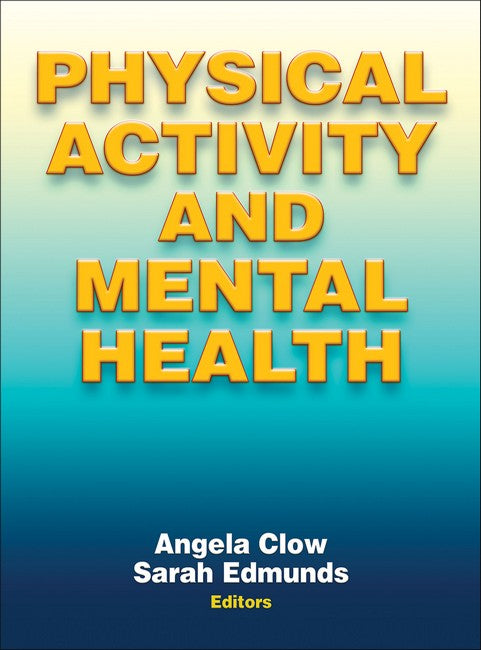Angela Clow, PhD, is a professor of psychophysiology in the department of psychology at the University of Westminster (London, United Kingdom). She also serves as the head of the department of psychology and leader of the psychophysiology and stress research group. Clow has garnered international acclaim for her research in the biological foundations of mental health. In 2002 she received the National Teaching Fellowship Award. Sarah Edmunds, PhD, is a research fellow in the department of psychology at the University of Westminster. Edmunds is a BPS-chartered psychologist and HCPC-registered sport and exercise psychologist. She is well regarded as both a researcher and teacher in sport and exercise psychology. As research partners, Clow and Edmunds combine their expertise in the areas of mental health and sport and exercise psychology to bring unique insight to the exploration of the connections between physical activity and mental health.
Request Academic Copy
Please copy the ISBN for submitting review copy form
Description
Part I: Introduction to Physical Activity and Mental Health Chapter 1. Relationship Between Physical Activity and Mental Health Angela Clow, PhD, and Sarah Edmunds, PhD 1. Science of Well-Being 2. Relationship Between Well-Being and Mental Health 3. Physical Activity as a Complex Behaviour 4. Biological Foundations of Effects of Physical Activity on Mental Health 5. Summary 6. References Chapter 2. Physical Activity Guidelines and National Population-Based Actions Fiona Bull, PhD, and Adrian Bauman, PhD 1. Population-Based Approach for Promoting Physical Activity 2. Physical Activity Guidelines 3. Development of the First National Physical Activity Guidelines 4. Current Best Practice in Developing Guidelines 5. Global, Regional and National Physical Activity Guidelines 6. Implementation and Influence of Physical Activity Guidelines 7. Summary 8. References Chapter 3. Challenges in Measuring Physical Activity in the Context of Mental Health Natalie Taylor, PhD 1. Types of Measurement Information 2. Factors That Affect Method Choice 3. Challenges in Measuring Physical Activity in a Mental Health Context 4. Available Methods for Measuring Physical Activity 5. Summary 6. References Part II: Factors Influencing the Interaction Between Mental Health and Physical Activity Chapter 4. Social Class Relationships in Physical Activity and Mental Health Mark Hamer, PhD 1. Inequalities in Social Health 2. Social Class and Exercise 3. Nature Versus Nurture 4. SES Mechanisms Linking Physical Activity and Health 5. Public Health Interventions 6. Summary 7. References Chapter 5. Physical Activity and Self-Esteem Magnus Lindwall, PhD, and F. Huelya Asci, PhD 1. Multidimensional Hierarchical Model of Self-Concept 2. Physical Self 3. Global Self-Esteem and Physical Self-Esteem Across the Life Span 4. Causality of the Relationship Between Physical Activity and Self-Esteem 5. Biopsychosocial Model of the Relationship Between Exercise and Physical Self 6. Implications for Practitioners and Researchers 7. Summary 8. References Chapter 6. Effects of Overtraining on Well-Being and Mental Health John S. Raglin, PhD, Gregory Wilson, PED, and Goran Kenttae, PhD 1. Paradox of Increased Training and Decreased Performance 2. Signs and Symptoms of Overtraining Syndrome 3. Treatment of Overtraining Syndrome 4. Prevalence and Susceptibility in Athlete Samples 5. Early Detection Using Physiological Measures 6. Early Detection Using Psychological Measures 7. Summary 8. References Chapter 7. Physical Functioning and Mental Health in Older Adults Donald H. Paterson, PhD, and Juan M. Murias, PhD 1. Physical Activity and Mortality 2. Physical Activity, Functional Abilities, Independence and Well-Being Into Older Age 3. Physical Activity, Cognitive Function and Mental Health in Older Adults 4. Physical Activity Guidelines for Older Adults 5. Aerobic Exercise-Training Interventions 6. Strength-Training Interventions 7. Exercise-Training Interventions and Cognitive Function 8. Exercise Programmes for Older Adults 9. Summary 10. References Chapter 8. Impact of Physical Activity on Mental Health in Long-Term Conditions Sarah Edmunds, PhD, and Angela Clow, PhD 1. Long-Term Conditions and Mental Health Issues 2. Long-Term Conditions and Quality of Life 3. Long-Term Conditions and Physical Activity 4. Chronic Obstructive Pulmonary Disease 5. Diabetes 6. Cancer 7. Summary 8. References Part III: Physical Activity and Mental Health Conditions Chapter 9. Depression and Anxiety Amanda Daley, PhD 1. Evidence Linking Depression and Exercise 2. Exercise and Postnatal Depression 3. Exercise and Antenatal Depression 4. Exercise and Anxiety 5. Exercise for Treating Depression and Anxiety 6. Exercise Versus Conventional Treatment for Depression and Anxiety 7. Promoting Exercise in the Treatment of Depression and Anxiety 8. Summary 9. References Chapter 10. Dementia and Alzheimer's Disease Juan Tortosa Martinez, PhD 1. Risk Factors and Pathophysiology for Dementia and Alzheimer's Disease 2. Need for Interventions 3. Physical Activity and the Prevention of Dementia and Alzheimer's Disease 4. Exercise Conditions Effective at Delaying the Onset of Dementia 5. Mechanisms by Which Physical Activity May Affect Dementia 6. Physical Activity for Attenuating the Progression and Symptoms of Dementia and Alzheimer's Disease 7. Physical Activity Interventions in Dementia and Alzheimer's Disease 8. Summary 9. References Chapter 11. Schizophrenia Guy Faulkner, PhD, and Paul Gorczynski, MA 1. Schizophrenia and Physical Health 2. Self-Report Physical Activity Measures in Schizophrenic Populations 3. Factors That Influence Physical Activity in Schizophrenic Populations 4. Physical Activity Interventions in Schizophrenic Populations 5. Promoting Exercise in the Treatment of Schizophrenia 6. Summary 7. References Chapter 12. Addictive Behaviour Michael Ussher, PhD 1. Links Between Physical Activity and Addictive Behaviours 2. Mechanisms Underlying the Role of Physical Activity in Treatments for Addiction 3. Physical Activity Interventions for Addictive Behaviours 4. Designing a Physical Activity Programme for Individuals With Addictions 5. Summary 6. References Chapter 13. Exercise Dependence, Eating Disorders, and Body Dysmorphia Brian Cook, PhD and Heather Hausenblas, PhD 1. Exercise Dependence 2. Eating Disorders and Body Dysmorphia 3. Impact of Exercise Dependence on Well-Being and Health 4. Relationship Between Exercise Dependence and Eating Disorders 5. Models of Exercise Dependence and Eating Disorders 6. Exercise in Body Dysmorphia 7. Strategies for Minimizing the Risk of Exercise Dependence 8. Summary 9. References

